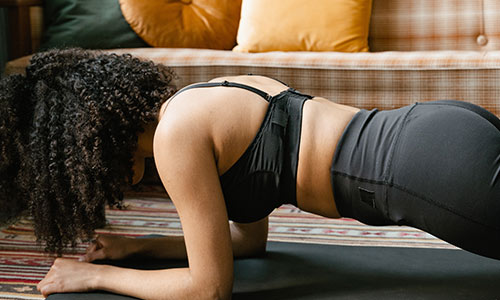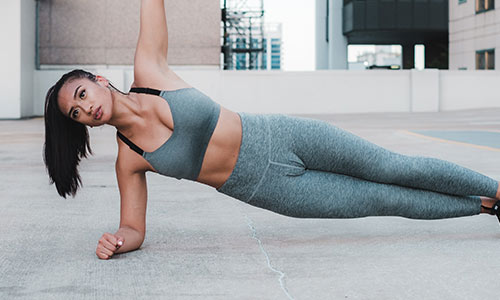Discover the Power of Planks for a Stronger Core
Author

Author, writer, artist, photographer, analyst, dreamer, geek, gamer. As a freelance writer and blogger for Outdoor Look, Pete writes about the outdoors and why you should be in it. In the time that is left over from camping, running, hiking, cycling, writing novels and being a full time analyst, Pete sometimes mows the lawn, when he's ordered by Mrs Gillham!
Are you tired of endless crunches and sit-ups that seem to yield minimal results? Do you long for a more effective and efficient way to strengthen your core and improve your overall fitness? If so, it's time to introduce yourself to the world of planks—a simple yet incredibly powerful exercise that has taken the fitness world by storm. Planks are not just another passing fitness trend; they're a tried-and-true exercise that delivers real results. Incorporating planks into your workout routine can offer a multitude of benefits for your overall health, whether you're a beginner or a seasoned gym-goer. In this comprehensive guide, we'll dive deep into the world of planks, their benefits, their proper form, and tips for maximizing your plank workouts. By the end, you'll have all the knowledge and tools you need to unlock your core strength, improve your posture, and enhance your overall fitness level—all through the power of planks.

Understanding the Essence of Planks
Planks, essentially represent a stationary exercise which is focused primarily on engaging the core muscles—comprising the abdominals, obliques, and lower back. The elegance of planks lies in their simplicity; which means it does not require any equipment. They offer versatility and can be executed virtually anywhere. This accessibility makes Planks an effective workout choice suitable for individuals of varying fitness levels.
The Many Benefits of Planks
Core Strength: Planks engage multiple muscle groups, including the core muscles like abs, obliques, and lower back which leads to improved core strength and stability.
Improved Posture: Strengthening the muscles supporting the spine through planks can help enhance posture, reducing the risk of postural imbalances and related issues.
Enhanced Balance and Stability: Planks challenge core, shoulder, and hip muscles, promoting better balance and stability.
Injury Prevention: Strengthening the core muscles with planks can reduce the risk of injuries, particularly those associated with the lower back and spine.
Plank Variations
Planks come in various forms, including standard, side, and with leg lifts, each targeting different muscle groups effectively. Here are a few plank variations that will help you understand what works best for you.
Standard Plank: Begin in a push-up position, with your hands directly beneath your shoulders and your body forming a straight line from head to heels. Hold this position for the desired duration, focusing on engaging the core muscles.
Side Plank: Lie on your side with your legs extended and stack your feet on top of each other. Prop yourself up on your elbow, ensuring it is directly beneath your shoulder. Lift your hips off the ground, creating a straight line from head to heels. Hold this position, then repeat on the opposite side.
Plank with Leg Lift: Start in a standard plank position. Lift one leg off the ground, keeping it straight and parallel to the floor. Hold for a few seconds, then lower the leg and repeat on the opposite side.

Mastering the Plank Form
Having the correct form is a very crucial aspect of Planks. Proper form ensures effective muscle engagement, prevents injury, and optimizes results for a stronger, more stable core. Here are a few tips with which you can kickstart your journey to loving Planks!
- Keep your body in a straight line from head to heels, avoiding any sagging or arching of the back.
- Engage your core muscles by drawing your navel toward your spine.
- Maintain a neutral spine and avoid lifting your hips too high or sinking them too low.
- Focus on breathing deeply and evenly throughout the exercise.
Author

Author, writer, artist, photographer, analyst, dreamer, geek, gamer. As a freelance writer and blogger for Outdoor Look, Pete writes about the outdoors and why you should be in it. In the time that is left over from camping, running, hiking, cycling, writing novels and being a full time analyst, Pete sometimes mows the lawn, when he's ordered by Mrs Gillham!
Categories
- Sport (28)
- Product Reviews (3)
- Team Outdoor Look (7)
- Mike Wild (2)
- Mike Payton (2)
- Suse Hammond-Pears (3)
- Snowboarding (12)
- Latest Offers (105)
- Shop Talk (1)
- Competitions (7)
- Walking (413)
- Lifestyle Fashion (8)
- Travel (86)
- Kit Guides (176)
- Workwear Clothing (6)
- Safety Workwear (4)
- Health/Fitness (289)
- Skiing (91)
- Great Outdoors (1316)
- Cycling (92)
- January 2025
- December 2024
- November 2024
- October 2024
- September 2024
- August 2024
- July 2024
- June 2024
- May 2024
- April 2024
- March 2024
- February 2024
- January 2024
- December 2023
- November 2023
- October 2023
- September 2023
- August 2023
- July 2023
- June 2023
- May 2023
- April 2023
- March 2023
- February 2023
- January 2023
- December 2022
- November 2022
- October 2022
- September 2022
- August 2022
- July 2022
- June 2022
- May 2022
- April 2022
- March 2022
- February 2022
- January 2022
- December 2021
- November 2021
- October 2021
- September 2021
- August 2021
- July 2021
- June 2021
- May 2021
- April 2021
- March 2021
- February 2021
- January 2021
- December 2020
- November 2020
- October 2020
- September 2020
- August 2020
- July 2020
- June 2020
- May 2020
- April 2020
- March 2020
- February 2020
- January 2020
- December 2019
- November 2019
- October 2019
- September 2019
- August 2019
- July 2019
- June 2019
- May 2019
- April 2019
- March 2019
- February 2019
- January 2019
- December 2018
- November 2018
- October 2018
- September 2018
- August 2018
- July 2018
- June 2018
- May 2018
- April 2018
- March 2018
- February 2018
- January 2018
- December 2017
- November 2017
- October 2017
- September 2017
- August 2017
- July 2017
- June 2017
- May 2017
- April 2017
- March 2017
- February 2017
- January 2017
- December 2016
- November 2016
- October 2016
- September 2016
- August 2016
- July 2016
- June 2016
- May 2016
- April 2016
- March 2016
- February 2016
- January 2016
- December 2015
- November 2015
- October 2015
- September 2015
- August 2015
- July 2015
- June 2015
- May 2015
- April 2015
- March 2015
- February 2015
- January 2015
- December 2014
- November 2014
- October 2014
- September 2014
- August 2014
- July 2014
- June 2014
- May 2014
- April 2014
- March 2014
- February 2014
- January 2014
- December 2013
- November 2013
- October 2013
- September 2013
- August 2013
- July 2013
- June 2013
- May 2013
- April 2013
- March 2013
- February 2013
- January 2013
- December 2012
- November 2012
- October 2012
- September 2012
- August 2012
- July 2012
- June 2012
- May 2012
- April 2012
- March 2012
- February 2012
- January 2012
- December 2011
- November 2011
- October 2011
- September 2011
- August 2011
- May 2010
- April 2010
- March 2010
- February 2010
- January 2010
- November 2009
- October 2009
- September 2009


Submit a Comment